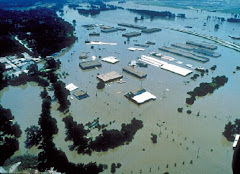How to Understand Global Warming
by Bob Strauss
Over the past 25 years or so, scientists around the world have observed a worrisome trend: the average temperature of the earth’s atmosphere and oceans has been increasing. Although global warming is a slow process—accounting for an increase of about 1 degree Fahrenheit over the course of the 20th century—it has profound implications. Here’s a quick guide to this much-argued, but little-understood, phenomenon
Step 1:
Blame the Greenhouse Effect. Some gases—notably carbon dioxide—tend to trap heat in the earth’s atmosphere, and as the concentration of these gases increases, so does the atmosphere’s temperature. Burning fossil fuels releases huge amounts of carbon dioxide, over and above the CO2 exhaled by humans and other animals. Worse, global C02 emissions have gone hand-in-hand with deforestation, meaning there aren’t as many trees to remove carbon dioxide from the atmosphere as there used to be.
Step 2:
One or two degrees make a big difference. A natural response to global warming is to say “So what’s the big deal? It’ll be an average of 76 degrees over the summer instead of 75 degrees.” True, that one degree won’t make much difference to your summer wardrobe, but it has a huge effect on the polar ice caps, which are slowly melting. As a result, scientists predict that average water levels around the world will rise anywhere from 10 to 100 feet over the next 100 years. (Even 10 feet would render many coastal cities uninhabitable.)
Step 3:
Global warming doesn’t necessarily mean “warm.” Here’s another observation by the average joe: “Jeez, it’s five degrees out! There goes your global warming!” Unfortunately, the way climate works, an average increase of one or two degrees in atmospheric temperature can actually cause some places to get colder, because of resulting changes in ocean currents. In other words, hundreds of years from now, it’s not inconceivable that global warming will cause a new Ice Age.
Step 4:
Get ready for some weird weather. Statistically, a 70-degree day in New York in January isn’t, by itself, evidence for global warming—nor are freak snowstorms in Denver, nor an unusually strong hurricane season, such as the U.S. experienced last year. However, taken together, these strong shifts in the weather indicate that something is awry in the way heat is being channeled from the atmosphere to the oceans, and vice versa—and the best guess is, you guessed it, global warming.
Step 5:
The situation isn’t hopeless. Faced with a planetary phenomenon like global warming, many folks will throw up their hands and say, “what can I do?” The fact is, though, that if we change our consumption patterns now—abandoning our SUVs, looking for alternative energy sources, preserving the Amazon rain forest, etc.—we can have a major impact on the future. If you’re concerned, you should at least alter your behavior—and if you don’t think that’s enough, get involved with an environmental group or write a letter to your congressperson

